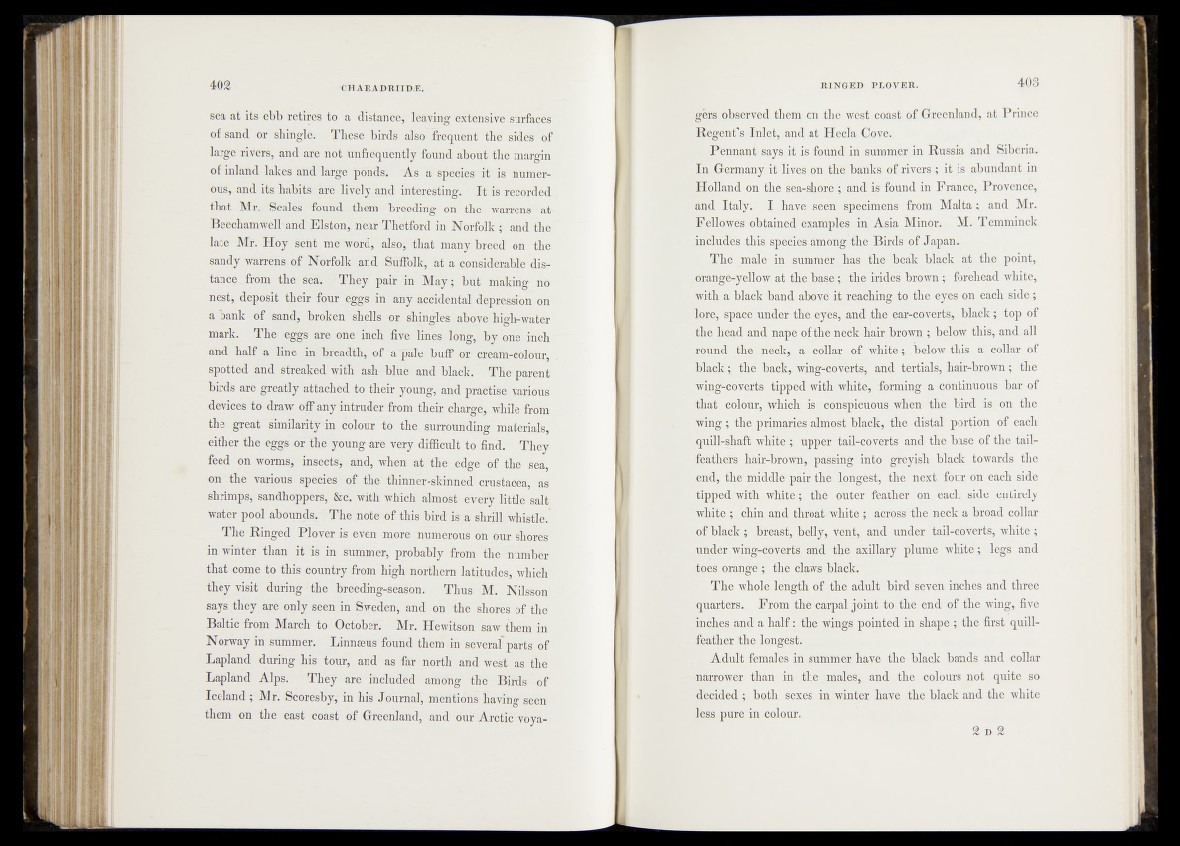
sea at its ebb retires to a distance, leaving extensive surfacës
of sand or shingle. These birds also- .frequent fh é sides of
large rivers, and are not unfrequently found about'#e margin
of inland-fakes and large pond's. As a spëdtes~it is numerous,
and its habits are lively and interesting! It ^recorded
that Mr. Scales found them breeding- &É the warrens - at*
Beechamwéll-and Elston, near ThSford in Norfolk ; and the"
late Mr. Hoy sent me word, also, that many f e e d on the
sandy warrens of Norfolk and Suffolk, ;1tt a |fe id fra b le distance,
from the seS. ; T hey pair in M a y b u t - making no
BÉÉ, deposit their four eggs in any accidental.depression OB
a bank of sand;, broken“ shells vor shingles above high-fatter
mark. The eggs are one inch five lines lo;%, pfefn ch
and half a line in- breadth, of a pale.buff or* cream-cfi'dhr, !
spotted and streaked’with ash-blue and black. The parent
birds are greatly attached to-their young, and practise various
devices to draw off any intruder from their charge, whiletfrfe
the great similarity'in colour to the. surrounding itfliterials,
either the eggs or the young are very difficulrtö ilnd. T h lf |
feed "on worms, insects, and, when at thggpdge of thé ‘sera,
on thé various speeies of the thinnër-skmned^crüstacéa, as
shrimps, sandhoppers, &e. with which almost ev e ry "life sa lt,
water pool abounds. The note~of this bird is a shrill y, biotic.
The Ringed Plover is even more numerous on our shores
in winter than it is in summer, probably from tKemuihber
that come to this country from high northern latitudes, wliich-
they visit during the breeding-season. Thus M. Nilsson
says they are only seen in Sweden, and on the shores of the
Baltic from March to October. Mr. Hewitson saw them in
Norway in summer. Linnaeus found themdn several*parts f e
Lapland during his tour, and as far north and west as the
Lapland Alps. They are included among the Birds Off
Iceland ; Mr. Scoresby^ in his Journal, mentions having seen
them on the east coast of Greenland, and our Arctic vbyagers
observed them ©n thy, west coast of Greenland, at Prince
Regent's, an dim; Hej[laj,QpvPjk
^ tPennanl sa« y.fetorihd in summer in Russia and Siberia,
InK e rmaBy it li^ ^ n ,k h e banks of rivers^; it is abundant in
in France^ Provence,
and Italy,,- spec||^®;S: from Marita,.; and. Mr.
Pt llow.es’ 6ll|®n^ck examples, i n |^ i a M in o ^ M. Temminck
in d u e s1 ,thifjape«^;amonge-the Birds of Japan.
,, The jnale "has Jhte‘4bea]^’.black at the point,
©renge-y^ow, at .the the Mailed* brown; forehead white,
with a black b a n # p :fe e it rcixghing to,,the IlgeS- on each sidejj
Sjme,, spa'ce under-th^^^^pnd .tfie ear-covertS^bl ack; top of
ih e he^d and nape d||he< heck hair-Brown; this, apd all
sSStind the,,, neck, a | dollar of .l^ ^ S th is a collar of.
blacky and hair-brown; the
ft iwif-ciixi rts,titopesd' With white, .f&rjqaing a coRtinu|||§" bar of
'that colour, eonspicu^s wheMulM bird is' on the
wiiify: u‘'^)iiniaries almo|||5lack,^p%‘ distal' pofji^'iof each
pftill-sliafkS^^^: upper ^picpverts and tlebap’O p f the tail-
Keathere haifcbrown, passing into griyhh.J?kick towards the
|md, ffi' middle“pair the lpngJsCi the next four on each side
»Ipedswith whit^h’Jlfed^ter feath^rlpn each side entirely
wfldic^icliin and throat whit l i l kcrdssritSyieck, a broad collar
pf^black Breast,, belljr, vent, and undtej^tap-coverts,, w h it^
under-wing-coyqrtsr and the axillary plumte white ;yjhgs and
llfes orange"*"; theij^lkws.fNabfc’’
The whole length of the adult birdfeven inches and three
.quarters. From the carpal joint ldrfh^^&d of the wing, five
inches and a half: (the wings pointed in shape.; the first quill-
feather "the longe$?.-^
, Adult females in summer have the black bands and collar
-narrower than the; males,, and the colours not quite so
decided ; both sexes in winter have the black and the white
less pure in colour.
2 d 2